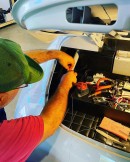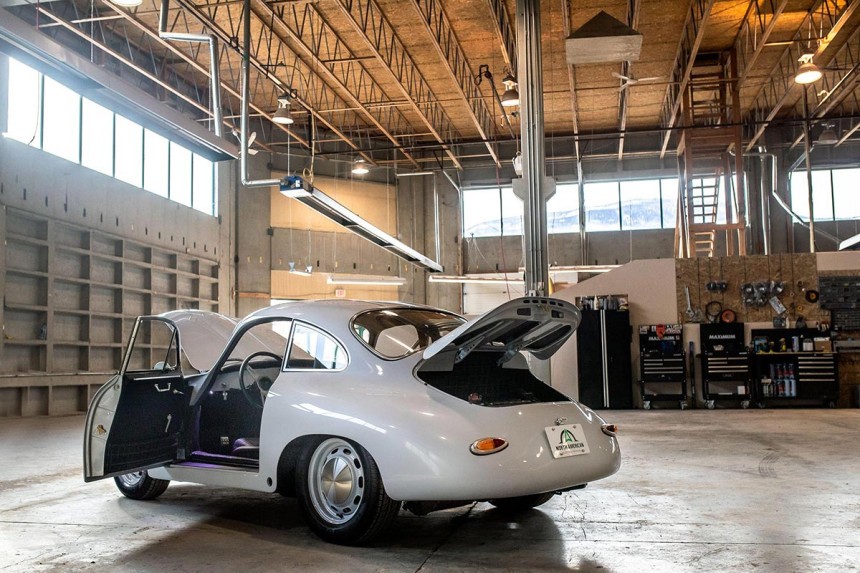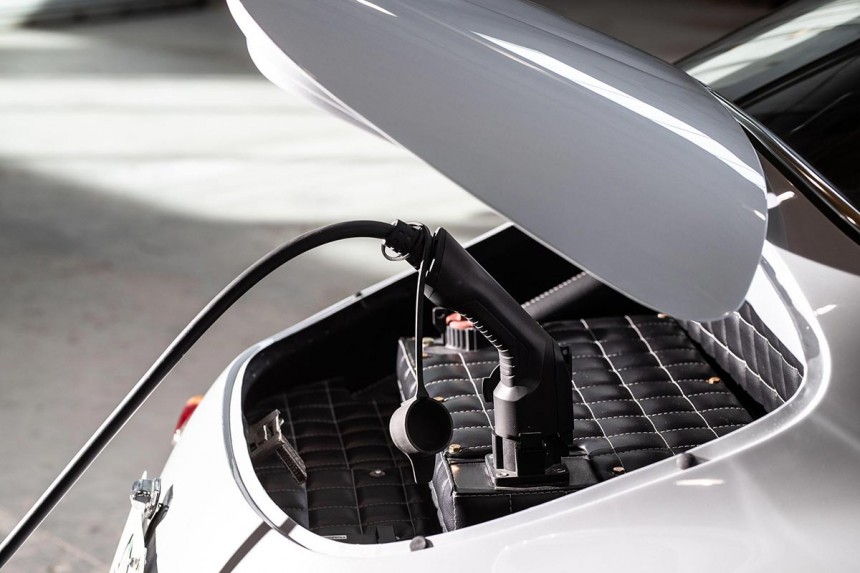From the start, I want to make it clear that it's not my intention to advertise this small Canadian company. Between you and me, it would probably require tens of thousands of articles about them to cover the cost of a converted car from their garage. I like what I see and want to share it with you, that's all. Actually, there's more, but I won't reveal my hidden agenda just yet.
I bet your first thought was that the name – North American Electric Vehicles – comes from an American custom builder, like EV West. Well, you would be wrong because NAEV is Canadian, from Oliver, British Columbia. That's about 1,300 miles north of San Marcos, CA, the home of EV West – which, as far as I know, is the most famous EV conversion company in the US. Please correct me if I'm wrong; in the meantime, let's see those Canadian goodies that caught my attention.
The Hummer brand was the victim of its excesses and was discontinued in 2009 – R.I.P. Hummer. Except the Hummer name is not dead. A decade later, it came back as the biggest electric passenger SUV that GM had to sell at that time. We didn't hear any praise from Arnold, probably because it's not an H1. We wonder what he has to say about this fresh electric H1 from NAEV.
First of all, it looks pretty good for a Humvee. That's because the guys at NAEV consider themselves more artists than mechanics who simply swap an ICE for an electric motor and batteries. For this project, they bought a Humvee decommissioned by the US Army, stripped it, and rebuilt it to look brand new.
Fortunately, this behemoth is made of aluminum, so the rust problems were few, and its boxy style allows for many technical customizations. No wonder the donor was a Tesla Model S. Its two electric motors developing 600 HP make it reach 60 mph in just 3 seconds, while the 85 kWh 400V battery pack is good for some 150 miles of range.
This value is half of what the new GMC Hummer EV is capable of, but there's always the option to double that range with only $20,000 more. Of course, one could argue that this way, the H1EV will be more expensive by a third than the modern toy. But you reckon that such a comparison is useless.
Just think of the 3,000 hours of manual work the H1EV requires, and you'll get another meaning of "value."
Today, maybe 30,000 copies of the predecessor of the iconic 911 are still left, which makes the 356 an attractive, reasonably priced oldtimer. At this point, it's interesting to note that the first conversion of NAEV was a 911 Targa from 1968. It was turned into an EV because rebuilding the original flat-six was much more costly!
Frankly, it's the first time I hear that a classic car was converted to an electric one because doing so is cheaper, not because the owner wanted to be greener. This could start a fascinating and lengthy discussion about why classic car enthusiasts should go electric: the electric powertrain is simply more efficient (the "zero-emissions" is just a bonus), and those who admire your car are mostly interested in its looks. But we'll talk about it some other time.
Now let's get back to this little electric Porsche. The '65 365 Cabriolet unit was simply a wreck when it got to the NAEV shop, and I can't even imagine the amount of time and passion these people put into it to make it look like a jewel. In fact, they broke their own rules! NAEV states that a good donor vehicle must be complete, rust-free (the restoration of metal parts could add around 2,000 hours of work!), and reasonably priced (around $45,000).
Well, this little Porsche was anything but. And this is why the result is so remarkable. As for the powertrain, there is no surprise here, as the donor was a Tesla, again. While the original car had a less than 100 HP four-cylinder petrol engine, this little feller is a little dragon with its 636 HP Tesla drive unit. In context, it's simply rivaling the 680 electric horsepower of the Porsche Taycan Turbo!
On the other hand, the 200 miles range is less than half of its modern offspring. That's because the 400-volt battery has 32 kWh capacity, only a third of Taycan's. But this little Porsche is not about taking long journeys. It's aimed at those who want a strong dose of electric adrenaline – for instance, the rear suspension is from a 911.
Still, this is hardly a spartan racer because the interior is covered by handcrafted Nappa leather (which took 500 hours to be completed), while the brushed nickel embellishments make it look millions. Well, the good news is that you don't have to pay millions of dollars for it.
The bad news is that you could buy two of the most expensive Taycans for the price of this electric 365 – which requires a whopping 575,000 CAD, or $435,000.
On the other hand, if you can indulge yourself with an expensive restored classic car and you're not the kind of purist obsessed by an obsolete technology – yes, ICE, it's you I'm pointing at – why not choose an electric converted classic jewel?
If the new GMC Hummer EV sucks for you, maybe the H1EV is the thing
The civil variant Hummer H1 was almost an abomination for car lovers, but it had its fans. The first to come to mind is Schwarzenegger, who apparently was the first client of an H1. Later on, the "Terminator" commissioned Austrian company Kreisel for the first G-Class and Hummer H1, respectively, converted to electric. Thank you, mister ex-eco-governor!The Hummer brand was the victim of its excesses and was discontinued in 2009 – R.I.P. Hummer. Except the Hummer name is not dead. A decade later, it came back as the biggest electric passenger SUV that GM had to sell at that time. We didn't hear any praise from Arnold, probably because it's not an H1. We wonder what he has to say about this fresh electric H1 from NAEV.
First of all, it looks pretty good for a Humvee. That's because the guys at NAEV consider themselves more artists than mechanics who simply swap an ICE for an electric motor and batteries. For this project, they bought a Humvee decommissioned by the US Army, stripped it, and rebuilt it to look brand new.
Fortunately, this behemoth is made of aluminum, so the rust problems were few, and its boxy style allows for many technical customizations. No wonder the donor was a Tesla Model S. Its two electric motors developing 600 HP make it reach 60 mph in just 3 seconds, while the 85 kWh 400V battery pack is good for some 150 miles of range.
This value is half of what the new GMC Hummer EV is capable of, but there's always the option to double that range with only $20,000 more. Of course, one could argue that this way, the H1EV will be more expensive by a third than the modern toy. But you reckon that such a comparison is useless.
Just think of the 3,000 hours of manual work the H1EV requires, and you'll get another meaning of "value."
The Porsche based on the Beetle is now a jewel
Porsche 356 is the first model produced by Porsche, and, as outrageous as it may seem now, it was a Beetle on steroids. Yes, I'm talking about that original Volkswagen Käfer, or Type 1, the "Flower Power" symbol that Hitler greenlighted – history is a b*tch, I know… While the Beetle holds the record for the longest-running car – it was produced in over 20 million units over 65 years – its sporty "cousin" is much rarer.Today, maybe 30,000 copies of the predecessor of the iconic 911 are still left, which makes the 356 an attractive, reasonably priced oldtimer. At this point, it's interesting to note that the first conversion of NAEV was a 911 Targa from 1968. It was turned into an EV because rebuilding the original flat-six was much more costly!
Frankly, it's the first time I hear that a classic car was converted to an electric one because doing so is cheaper, not because the owner wanted to be greener. This could start a fascinating and lengthy discussion about why classic car enthusiasts should go electric: the electric powertrain is simply more efficient (the "zero-emissions" is just a bonus), and those who admire your car are mostly interested in its looks. But we'll talk about it some other time.
Well, this little Porsche was anything but. And this is why the result is so remarkable. As for the powertrain, there is no surprise here, as the donor was a Tesla, again. While the original car had a less than 100 HP four-cylinder petrol engine, this little feller is a little dragon with its 636 HP Tesla drive unit. In context, it's simply rivaling the 680 electric horsepower of the Porsche Taycan Turbo!
On the other hand, the 200 miles range is less than half of its modern offspring. That's because the 400-volt battery has 32 kWh capacity, only a third of Taycan's. But this little Porsche is not about taking long journeys. It's aimed at those who want a strong dose of electric adrenaline – for instance, the rear suspension is from a 911.
The bad news is that you could buy two of the most expensive Taycans for the price of this electric 365 – which requires a whopping 575,000 CAD, or $435,000.
There you are: two fine examples of classic cars successfully converted to electric
Although neither is to my taste, I can't help but like the result. A lot. Of course, such a hobby costs a lot, but this is mainly because this "industry" – EV conversions and DIY restorations – is primarily based on customization. There's no such thing as a universal plug-and-play electric drive, along with batteries, controllers, converters, and so on.On the other hand, if you can indulge yourself with an expensive restored classic car and you're not the kind of purist obsessed by an obsolete technology – yes, ICE, it's you I'm pointing at – why not choose an electric converted classic jewel?























